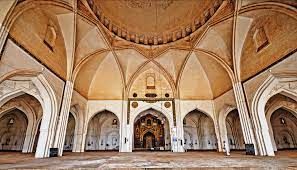Gol Gumbaz - India's only Whispering Gallery
India's only Whispering Gallery
The Gol Gumbaz, a mausoleum that is prominently included in many Bijapur travel packages, is more than simply a mausoleum; it is a tribute to the glory of the Adil Shahi empire in Southern India. The Gol Gumbaz in Bijapur is one of India's most well-known mausoleums, displaying art and architectural aspects from a bygone age. The majestic building, also known as the Gol Ghumat, is maintained by the Archaeological Survey of India and draws a large number of people from India and outside who come to see the monument's captivating architecture and unique acoustic qualities. The Gol Ghumat in Bijapur is also one of the most important Muslim monuments in India's south.
In the 17th century, Mohammed Adil Shah governed Bijapur. Adil Shah intended to create himself a mausoleum bigger and better than his father's tomb in 1626, when he had just recently won the kingdom, and began construction on the Gol Gumbaz. The edifice was ultimately finished 30 years later, in 1656, after Mohammed Adil Shah had breathed his last breath. The Gol Gumbaz is claimed to be the world's largest dome, second only to St. Peter's Basilica in Rome, a fact that has helped this magnificent structure become well-known throughout history. The Sultan's mortal remains, as well as those of his two wives, Taj Jahan Begum and Aroos Bibi, his daughter, grandson, and other relatives, are interred at the Bijapur Gol Gumbaz.
The Gol Gumbaz is one of the finest examples of the Deccan Indo-Islamic style of architecture. Covering an area of 18000 sq. ft., the mausoleum is also one of the world’s largest single-chamber spaces. The Gol Ghumat of Bijapur was designed by Yaqut of Dabul and has been built using dark grey basalt. Reaching a height of 51 metres, Bijapur ka Gol Gumbaz (the Gol Gumbaz of Bijapur) has four seven-storey high dome-capped towers adorning its four sides.
When visitors enter the main mausoleum hall at Bijapur’s Gol Gumbaz, they will be able to see a square podium covered by an intricately carved wooden canopy. In the middle of the podium is a cenotaph slab that marks the actual tomb of the Sultan, Mohammed Adil Shah.
Gol Gumbaz is also well known for the fact that the giant structure stands tall and proud even though it has no pillars or towers to support its huge dome. The dome is nothing less than an architectural marvel and is held up from the inside by eight intersecting arches.
When you walk into an old monument, hearing a faint echo of your voice is quite common given the size and bareness of the complex. However, when it comes to Gol Gumbaz, this occurrence transforms into a full-blown phenomenon in the whispering gallery. The gallery runs around the inner periphery of the dome and any sound that is made here, even if it is a whisper, is amplified by the unique structure, which can carry it across a distance of up to 40 metres. Not only will you be able to hear a whisper from the other side of the monument, but the impressive acoustics of the Bijapur Gol Gumbaz will create an echo that repeats the sound 7-10 times.
Again located in the same complex, the Nakkar Khana is also called the drum house. It is believed that the Nakkar Khana was built to offer a grand and royal welcome to the king’s visitors to the Bijapur Gol Gumbaz by beating drums. This was an age-old tradition that was followed during the reception of royal guests. Before the entire complex came under the jurisdiction of the ASI in 1962, the British converted the drum house into a museum to store old artefacts. In 1912, it came under the control of the District collectorate and is one of the oldest museums in India.
The Best Time to Visit Bijapur
During the summers, the region tends to get very hot and dry which does not make for very comfortable weather to enjoy sightseeing. The monsoons can be a good time to tour the Bijapur Gol Gumbaz but the heavy rains may still put a damper on your plans. That being said, during the months from October to the end of March, the state experiences temperatures ranging from 20 to 30° C. The pleasant weather can elevate your Bijapur Gol Ghumat sightseeing experience even further.
You do not have to be an architecture enthusiast to appreciate the splendour of this popular mausoleum. One of the best places to visit in Bijapur, the Gol Gumbaz is definitely worth including in your itinerary. You can also book tickets to the Bijapur Gol Ghumat online and plan a trip to this small town in Karnataka that promises a close rendezvous with art and history.
If reading my blog excites you then, do not miss to watch the detailed video on the GOL GUMBAZ on my channel Travelution and if you like my work do consider subscribing to my channel and share it with your travel enthusiast buddies & family members until next time it's me Nikkhil signing off...






